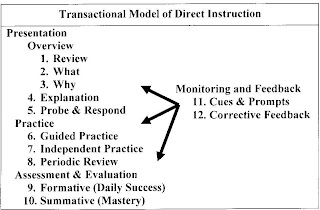The behavior model has to do with the behaviorism theory. This means that behavior and the ones environment can determine human behavior and learning. The behavior model is a direct instruction strategy. It addresses students basic skills and knowledge. This type of instruction is facilitated by the teacher by demonstrating or lecture basic skills to helps students master them. This instruction has and introduction, development, and closure. The opening can include an anticipatory set and pre-assessment. The development or presentation is guided practice, independent practice, feedback, and sometimes assessment. The closure can end with homework or assessment to test the students' knowledge.
I am better aware of the direct instruction strategy after working with it in class. I do like this model and I feel that it is imperative to use this in the classroom. I do however, think that this strategy of teaching is not complex and does not allow for students' multiple intelligences and learning styles. I will use direct-instruction at the beginning of each new unit. I will introduce the topic and get the students familiar with concepts or skills they may need to master for the unit. I will use the step-by-step process to get each student on the same page so they can understand the basic skills and knowledge of the content being studied. I will promise not to resort to this method for each lesson though. It is probably the easiest strategy to use when planning a lesson, but it will not always engage students. I want my students to always be engaged so they do not go off task. I want to learn about the other model of teaching so that I can learn how to get creative with lesson plans in the classroom. I want my students to have fun while learning and I think using different approaches to teaching will help me do this. I want every student to reach meta-cognition and they will be able to do so once they can be creative and think for themselves.

This is a great way to design direct instruction lessons. This is exactly what we talked out in class. This outline clearly shows how to design the lesson. Now I can always go back and reference this when I need to think about making a direct instruction lesson when I am playing to introduce a new topic to my students.

The concept map about the direct instruction was very helpful. I liked the idea that we were allowed to work on it by ourselves, and then edit it once we really got into an in-depth discussion of the strategy in class. I realized that I had the basic concept down about the topic, but there were some areas I was unsure. I did not realize that Albert Bandura's technique of modeling had to do with direct instruction so I added that to my graph when we were able to edit it. It makes sense though because the teacher models and demonstrates everything so the students will repeat and later memorize that task.
I hope we continue to use the concept map for each strategy and model we learn this semester.It has helped me realize my mistakes and gave me a change to fix them which was a big help for me to learn. I would use this idea in my own classroom. If we were studying a certain topic, I would have students pair up and fill-in the graphic organizer I provide for them. Then, I would have each student pair up with a different person and have them make changes and add things they seen in the other persons. Then, as a class we could discuss our ideas together to make a huge collaboration of ideas. The organizer can be taken home as a study guide also. The organizer serves as a great way to learn a new topic and to expand on it. Hopefully I can have students do the graphic organizers on the computer that way they can incorporate technology and continually add to it. They will have it always saved on the computer too if they ever need to reference it. The map is a very useful tool to both the teacher and students and I will definitely use it in my classroom for all those reasons.
The presentations on direct instruction were great. I am glad that we were able to learn about direct instruction through the classes power points instead of just reading some text. Not only did we get to practice being in front of the class, we also got to get an in-depth idea of the different steps of direct instruction. Now we are able to view everyone's power points to go back in case we missed anything important. Having students use power points is a great idea. Not only are the ones who are doing the power point learning, the rest of the class is learning what they are teaching. I will definitely implement projects like this with my own class so that they too can learn to become comfortable in front of the class, and they can also learn in a different way from the usual lecture.


No comments:
Post a Comment